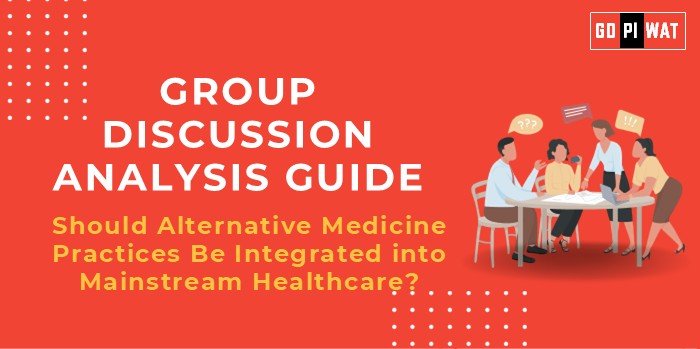📋 Group Discussion (GD) Analysis Guide: Should Alternative Medicine Practices Be Integrated into Mainstream Healthcare?
🌍 Introduction to the Topic
📖 Opening Context
In recent years, alternative medicine, including practices like Ayurveda, acupuncture, and homeopathy, has gained global attention. With increased focus on holistic health and rising healthcare costs, integrating alternative medicine into mainstream systems has become a pivotal debate in global health policy.
📜 Topic Background
Alternative medicine refers to non-conventional medical practices used alongside or instead of standard medical treatments. These systems, rooted in cultural traditions or innovative methodologies, include disciplines such as traditional Chinese medicine, naturopathy, and yoga therapy. Efforts to integrate these practices, like WHO’s Traditional Medicine Strategy 2014-2023, aim to make healthcare more inclusive and culturally relevant.
📊 Quick Facts and Key Statistics
- 💰 Global Market Value: The global alternative medicine market was valued at $82 billion in 2023, projected to grow at 22% annually by 2030.
- 👥 Patient Use: Nearly 70% of individuals in low-income countries rely on alternative medicine for primary care.
- 🌍 WHO Data: 88 countries have policies on traditional medicine integration.
- 🇮🇳 India’s Role: AYUSH Ministry oversees 7 lakh registered practitioners and contributes 2% of India’s healthcare spending.
🤝 Stakeholders and Their Roles
- 🏛️ Governments: Regulate, fund research, and implement integration policies.
- 🏥 Healthcare Providers: Adapt systems for holistic treatment.
- 👥 Patients: Drive demand through preference for natural therapies.
- 🌍 International Organizations: (e.g., WHO) Provide guidelines and promote cross-border collaboration.
🏆 Achievements and Challenges
✨ Achievements
- 🤝 Increased Acceptance: Global collaborations, such as WHO’s endorsement of yoga.
- 📚 Research Support: Ayurveda’s use in managing chronic diseases like arthritis.
- 💵 Cost-Effectiveness: Traditional medicine significantly reduces healthcare costs in developing regions.
⚠️ Challenges
- 📉 Standardization Issues: Lack of regulatory frameworks and evidence-based validation.
- 🔍 Risk of Misuse: Untrained practitioners leading to harmful outcomes.
- ⚖️ Ethical Concerns: Commercialization of cultural knowledge.
🌎 Global Comparisons
- 🇨🇳 Success: China’s integration of traditional Chinese medicine (TCM) has improved chronic illness outcomes.
- 🇺🇸 Challenges: The U.S. struggles with integrating complementary therapies into its insurance model.
📖 Case Studies
- 🇮🇳 India’s AYUSH System: Integration into primary healthcare has improved rural access.
- 🇰🇷 South Korea: Acupuncture is covered under health insurance.
💡 Structured Arguments for Discussion
- 👍 Supporting Stance: “Integrating alternative medicine into mainstream healthcare improves holistic care and reduces costs.”
- 👎 Opposing Stance: “The lack of scientific evidence for many practices makes integration risky.”
- ⚖️ Balanced Perspective: “While alternative medicine offers unique advantages, careful integration and regulation are crucial.”
📈 Effective Discussion Approaches
🔑 Opening Approaches
- 🌍 Global Health Angle: “With 88 nations adopting policies, this is a global shift, not just a national debate.”
- 📊 Statistical Start: “70% of patients in low-income countries already rely on traditional practices for healthcare.”
- 📖 Case-Based Introduction: “India’s AYUSH ministry serves as a pioneering model for integration.”
🤔 Counter-Argument Handling
- 📚 Emphasize evidence-based successes, like clinical trials on Ayurvedic treatments.
- 🔒 Highlight regulatory measures mitigating safety concerns.
🔍 Strategic Analysis of Strengths and Weaknesses
- 🌟 Strengths: Promotes preventive care; cost-efficient, especially in rural areas; high cultural acceptance.
- ⚠️ Weaknesses: Lack of standardized research; limited insurance coverage.
- 🚀 Opportunities: Research collaboration; training programs for mainstream practitioners.
- ⚡ Threats: Resistance from conventional medicine stakeholders; over-commercialization risks.
📚 Connecting with B-School Applications
- 🌐 Real-World Applications:
- 📋 Project themes: Healthcare cost reduction, rural outreach programs.
- 📊 Cross-disciplinary research: Combining data analytics with traditional medicine.
- 💬 Sample Interview Questions:
- 🧠 “How can alternative medicine address the challenges of universal healthcare?”
- 📚 “What role does evidence-based research play in integrating traditional practices?”
- 💡 Insights for B-School Students:
- 🚀 Opportunities for innovation in healthcare delivery.
- ⚖️ Exploring ethical frameworks for integration.


